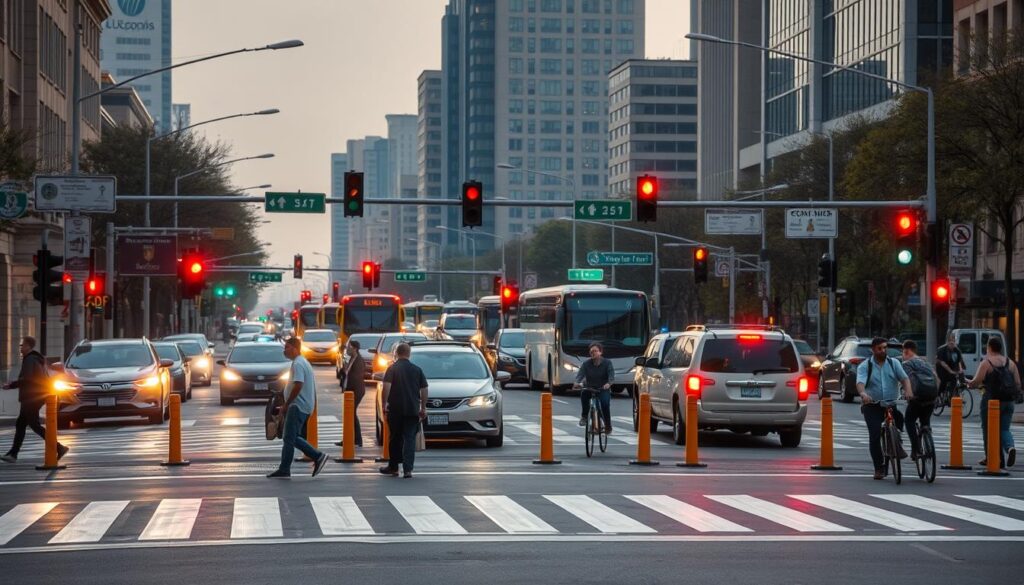Can our roads be made safer through design and technology? The answer lies in the crucial work of traffic engineers who are dedicated to reducing accidents and enhancing transportation safety.
Traffic engineers play a vital role in ensuring the safety of our roads by designing and implementing effective safety measures. With advancements in technology, such as Intelligent Transportation Systems (ITS), the landscape of road safety engineering is undergoing a significant transformation.
By leveraging these advancements, traffic engineers can significantly improve the safety and efficiency of our transportation networks.
Key Takeaways
- Traffic engineers are crucial in enhancing transportation safety.
- Intelligent Transportation Systems (ITS) are revolutionizing road safety engineering.
- Effective safety measures can significantly reduce accidents.
- Technological advancements are key to improving transportation networks.
- Road safety engineering plays a vital role in saving lives.
Understanding Road Safety Engineering
As urban areas continue to grow, the need for robust road safety engineering practices becomes increasingly important. Road safety engineering is a vital aspect of urban planning, focusing on the design and improvement of roads to minimize crashes and ensure safe travel for all users.
Definition of Road Safety Engineering
Road safety engineering involves the application of engineering principles to design and improve road infrastructure. This includes road safety audits to identify potential hazards and implement corrective measures. A comprehensive road safety audit assesses various factors, including road geometry, intersection design, and signage.
Importance in Urban Planning
In urban planning, road safety engineering plays a crucial role in creating safer urban environments. By integrating safety considerations into the planning process, cities can reduce the risk of accidents and promote sustainable transportation. Effective road safety engineering practices contribute to the overall quality of life for urban residents.
Relationship with Traffic Management
Road safety engineering is closely related to traffic management, as both disciplines aim to ensure the safe and efficient movement of people and goods. Traffic management strategies, such as traffic signal optimization and intelligent transportation systems, complement road safety engineering efforts by reducing congestion and minimizing the risk of accidents.
| Aspect | Road Safety Engineering | Traffic Management |
|---|---|---|
| Primary Focus | Designing safe road infrastructure | Managing traffic flow and congestion |
| Key Strategies | Road safety audits, hazard mitigation | Traffic signal optimization, ITS |
| Goals | Reduce accidents, enhance safety | Improve traffic flow, reduce congestion |
By understanding the principles of road safety engineering and its relationship with traffic management, cities can develop more effective strategies to enhance road safety and promote sustainable transportation.
Key Principles of Road Safety
To enhance road safety, it’s crucial to adopt a holistic approach that incorporates human factors, design elements, and safety hierarchies. Effective road safety engineering is not just about designing roads; it’s about creating a safe environment for all users.
Human Factors in Road Safety
Human factors play a significant role in road safety, as driver behavior and errors can lead to crashes. Understanding driver psychology and behavior is essential in transportation engineering to design roads that minimize the risk of accidents.
For instance, designing roads with clear signage and intuitive layouts can significantly reduce driver confusion and errors. Moreover, incorporating elements that reduce driver stress and fatigue can enhance overall road safety.

Designing for Vulnerable Road Users
Vulnerable road users, such as pedestrians and cyclists, are disproportionately affected by road crashes. Therefore, designing roads with these users in mind is crucial. This includes creating dedicated lanes for cyclists and ensuring that pedestrian crossings are safe and visible.
In highway design, it’s essential to balance the needs of different users. For example, implementing speed reduction measures in areas with high pedestrian activity can significantly enhance safety.
The Safety Hierarchy
The safety hierarchy is a fundamental principle in road safety that prioritizes measures to prevent crashes. It typically involves a three-tiered approach: preventing crashes from occurring in the first place, minimizing the severity of crashes when they do occur, and providing post-crash care.
In the context of crash investigation, understanding the safety hierarchy helps in identifying the most effective measures to reduce the incidence and impact of crashes. By prioritizing prevention, road safety engineers can design safer roads that are more forgiving when accidents happen.
By integrating these key principles—understanding human factors, designing for vulnerable users, and adhering to the safety hierarchy—road safety engineers can significantly enhance the safety of our roads. This holistic approach is fundamental to effective transportation engineering and highway design.
The Role of Technology in Road Safety
The integration of technology in road safety has revolutionized the way we approach traffic management and accident prevention. With the advent of innovative solutions, the transportation sector is witnessing a significant shift towards enhanced safety measures.
Intelligent Transportation Systems
Intelligent Transportation Systems (ITS) are playing a pivotal role in modernizing road safety. By leveraging real-time data and advanced communication technologies, ITS enables efficient traffic control devices management, reducing congestion and minimizing the risk of accidents. For instance, dynamic traffic signal control systems can adjust signal timings based on real-time traffic conditions, thereby optimizing traffic flow and reducing the likelihood of collisions.
Moreover, ITS facilitates the implementation of smart infrastructure, such as smart highways equipped with sensors and cameras to monitor traffic conditions. This infrastructure can provide real-time information to drivers, enhancing their awareness and decision-making on the road.
Advanced Driver Assistance Systems
Advanced Driver Assistance Systems (ADAS) are another crucial technology in the realm of road safety. These systems utilize a combination of sensors, cameras, and radar to provide drivers with critical assistance, such as lane departure warnings, adaptive cruise control, and automatic emergency braking. By augmenting driver capabilities, ADAS can significantly reduce the incidence of accidents caused by human error.
The effectiveness of ADAS in enhancing road safety is underscored by its potential to mitigate the severity of crashes. For example, automatic emergency braking systems can prevent or mitigate frontal collisions, thereby reducing the risk of injury or fatality.
Data Analytics for Safety Improvements
Data analytics is a powerful tool in the quest to improve road safety. By analyzing data from various sources, including crash records, traffic volume counts, and sensor data, transportation agencies can identify high-risk areas and develop targeted interventions. Transportation network engineering plays a vital role in this process, as it involves designing and optimizing transportation systems to enhance safety and efficiency.
The application of data analytics in road safety involves several key steps, including data collection, analysis, and interpretation. By leveraging advanced analytical techniques, transportation agencies can uncover insights that inform the development of effective safety measures, such as improving road geometry, enhancing signage, and implementing intelligent traffic management strategies.
The Impact of Road Design on Safety
Effective road design is essential for minimizing the risk of accidents. The layout and geometry of roads play a significant role in determining their safety. A well-designed road can significantly reduce the number of crashes and enhance safety for all users.

Road Geometry and Safety
Road geometry refers to the physical layout of a road, including its alignment, curvature, and gradient. Proper road geometry is crucial for ensuring safety on the roads. For instance, a road with a smooth alignment and appropriate curvature can reduce the risk of accidents. According to a road design guide, using tools like AutoCAD Civil 3D can help engineers design roads with optimal geometry.
Sharp curves or steep gradients can lead to loss of control, especially at high speeds. Therefore, it’s essential to design roads with safety in mind, taking into account factors like sight distance and stopping distance.
Intersection Design Considerations
Intersections are critical points on a road network where the risk of accidents is higher due to the convergence of traffic from different directions. Proper intersection design is vital for reducing the risk of crashes. This includes designing clear and visible intersections, using appropriate signage and markings, and ensuring adequate lighting.
Designing intersections with safety in mind involves considering factors like traffic volume, speed, and pedestrian activity. For example, roundabouts can be an effective way to manage traffic flow and reduce accident risk.
Signage and Marking Best Practices
Signage and markings are critical components of road design that provide vital information to drivers, pedestrians, and other road users. Clear and consistent signage helps guide users through the road network, while markings provide visual cues for lane discipline and other safety-related information.
Best practices for signage and markings include using clear and legible fonts, ensuring adequate reflectivity for nighttime visibility, and maintaining consistency in signage across the road network. Regular maintenance is also crucial to ensure that signage and markings remain effective over time.
By focusing on these aspects of road design, engineers can significantly enhance safety on the roads, reducing the risk of accidents and creating a safer environment for all users.
Evaluating Road Safety Performance
Evaluating road safety performance is a critical aspect of reducing accidents and enhancing overall transportation safety. It involves a comprehensive assessment of various factors that contribute to road safety.
Safety Audits and Inspections
Safety audits and inspections are essential tools for evaluating road safety performance. These processes involve a systematic examination of road infrastructure to identify potential safety hazards. A thorough safety audit can help in detecting design flaws, inadequate signage, and other safety concerns. For more detailed information on safety audits, refer to the roadway safety assessment guidelines.
Crash Data Analysis
Crash data analysis is a critical component of evaluating road safety performance. It involves collecting and analyzing data on road crashes to identify patterns and causes. This information can be used to develop targeted interventions to reduce the number of crashes. Effective crash investigation is crucial for understanding the factors that contribute to road accidents.
Performance Metrics
Performance metrics are used to measure the effectiveness of road safety initiatives. These metrics can include crash rates, injury severity, and other relevant indicators. By tracking these metrics, transportation agencies can identify areas for improvement and evaluate the impact of their safety initiatives.
| Performance Metric | Description | Example |
|---|---|---|
| Crash Rate | Number of crashes per vehicle mile traveled | 100 crashes per 100 million vehicle miles |
| Injury Severity | Measure of the severity of injuries in crashes | Percentage of crashes resulting in serious injuries |
| Fatality Rate | Number of fatalities per vehicle mile traveled | 1 fatality per 100 million vehicle miles |
By using these performance metrics, transportation agencies can enhance road safety and reduce the number of accidents on the roads.
Road Safety Strategies and Plans
Effective road safety engineering is supported by robust strategies and plans that address the unique challenges of different regions. These plans are crucial for identifying safety concerns, allocating resources, and implementing measures to reduce accidents.

Creating a Road Safety Plan
Creating a comprehensive road safety plan involves several key steps. First, it’s essential to conduct a thorough analysis of the current road safety situation, including identifying high-risk areas and understanding the causes of accidents. This analysis helps in setting clear, achievable goals for improving road safety.
Data collection is a critical component of this process, involving the gathering of information on crash incidents, traffic volume, and other relevant factors. This data is then used to prioritize safety interventions and allocate resources effectively.
Stakeholder Involvement
Stakeholder involvement is vital for the success of road safety plans. This includes collaboration with government agencies, local authorities, law enforcement, and community groups. By working together, these stakeholders can share knowledge, resources, and expertise to develop more effective safety strategies.
- Government agencies provide regulatory support and funding.
- Local authorities offer insights into community needs and specific challenges.
- Law enforcement agencies play a crucial role in enforcing traffic laws.
- Community groups help in raising awareness and promoting road safety initiatives.
Community Engagement Initiatives
Community engagement is a cornerstone of successful road safety strategies. Initiatives such as public awareness campaigns, educational programs in schools, and community events can significantly enhance road safety. These initiatives not only educate the public about safe driving practices but also encourage community members to take an active role in improving road safety.
By engaging with the community, road safety engineers can develop plans that are tailored to the specific needs and concerns of the local population, thereby increasing the effectiveness of their interventions.
Legislative Framework and Policies
Understanding the legislative framework is crucial for enhancing road safety across the United States. The framework encompasses a wide range of regulations and policies at the federal, state, and local levels, all of which play a significant role in shaping road safety engineering practices.
Federal Regulations and Guidelines
Federal regulations set the foundation for road safety standards nationwide. Agencies such as the Federal Highway Administration (FHWA) and the National Highway Traffic Safety Administration (NHTSA) develop and enforce guidelines that impact road design, vehicle safety standards, and driver behavior.
- Uniform Traffic Control Devices Manual: Provides standards for traffic signs, signals, and markings.
- Highway Safety Improvement Program: Focuses on improving safety through infrastructure projects.
- Federal Motor Carrier Safety Regulations: Regulates the safety of commercial vehicles.
State-Level Road Safety Programs
State-level programs complement federal regulations by addressing specific regional needs and challenges. States have the flexibility to implement their own safety initiatives, such as:
- Traffic Safety Commissions: Many states have commissions that oversee traffic safety efforts.
- Ignition Interlock Laws: Some states have implemented laws requiring ignition interlocks for DUI offenders.
- Graduated Driver Licensing: Programs that gradually introduce new drivers to driving privileges.
Local Ordinances and Their Impact
Local ordinances can have a direct and significant impact on road safety within communities. Municipalities can enact laws and regulations tailored to their specific needs, such as:
- Speed Limit Adjustments: Local governments can adjust speed limits based on road conditions and traffic patterns.
- Traffic Calming Measures: Techniques like speed bumps and narrowed roadways to reduce speeding.
- Public Transportation Policies: Regulations that promote safe and efficient public transit.
By understanding and leveraging these different levels of legislation, communities can develop comprehensive road safety plans that address their unique challenges and opportunities.
Case Studies on Road Safety Engineering
Examining successful road safety initiatives in major cities provides valuable insights into effective engineering solutions. By analyzing these case studies, we can understand the strategies that have been implemented to enhance road safety and reduce accidents.
Successful Safety Initiatives in Major Cities
Several major cities have made significant strides in improving road safety through innovative engineering solutions. For instance, cities like New York and London have implemented comprehensive traffic management systems, including intelligent traffic signals and dedicated bike lanes, to reduce congestion and enhance safety.

| City | Initiative | Outcome |
|---|---|---|
| New York | Installation of intelligent traffic signals | 20% reduction in traffic congestion |
| London | Dedicated bike lanes | 15% increase in cycling safety |
| Tokyo | Advanced pedestrian crossing systems | 30% reduction in pedestrian accidents |
Lessons Learned from Global Examples
Global examples offer a wealth of knowledge on road safety engineering. Cities like Tokyo have implemented advanced pedestrian crossing systems, significantly reducing pedestrian accidents. These examples provide valuable lessons for other cities looking to improve their road safety.
- Comprehensive planning: Successful initiatives often start with thorough planning and assessment.
- Community engagement: Engaging with the local community is crucial for the success of road safety initiatives.
- Continuous evaluation: Regular assessment and adaptation of safety measures are key to achieving long-term results.
Analyzing Failures for Future Improvements
Analyzing failures in road safety engineering is equally important as studying successes. By understanding what hasn’t worked, cities can avoid similar pitfalls and develop more effective strategies. For example, a study on the failure of a particular traffic management system in a European city revealed that inadequate data analysis led to its ineffectiveness.
“The key to improving road safety lies not only in celebrating our successes but also in learning from our failures.”
By embracing both successes and failures as learning opportunities, cities can continue to evolve and improve their road safety engineering practices, ultimately creating safer roads for everyone.
Road Safety Education and Awareness
Effective road safety education is crucial for reducing accidents and enhancing transportation safety. By educating the public, especially vulnerable road users such as children and pedestrians, we can significantly reduce the number of road-related injuries and fatalities.
Importance of Public Awareness Campaigns
Public awareness campaigns are a vital tool in the quest to improve road safety education. These campaigns use various media channels to disseminate information about safe driving practices, the importance of wearing seatbelts, and the dangers of distracted driving. By raising awareness, we can change behaviors and attitudes towards road safety.
- Campaigns can be tailored to specific audiences, such as young drivers or elderly pedestrians.
- Utilizing social media platforms can amplify the reach of these campaigns.
- Collaborating with influencers and community leaders can enhance the credibility and impact of the messages.
Engaging Schools and Communities
Engaging schools and local communities is fundamental to fostering a culture of safety. Educational programs in schools can teach children about road safety from an early age, while community programs can target a broader audience. This multi-faceted approach ensures that public awareness is raised across different demographics.
- Schools can integrate road safety into their curriculum.
- Community events can serve as platforms for disseminating road safety information.
- Workshops and seminars can provide in-depth knowledge on specific road safety issues.
Collaborating with NGOs and Advocacy Groups
Non-Governmental Organizations (NGOs) and advocacy groups play a significant role in promoting road safety education. These organizations often have the resources and expertise to develop targeted campaigns and programs. By collaborating with them, governments and other stakeholders can leverage their efforts to achieve greater impact.
Through these collaborative efforts, we can ensure that road safety education is comprehensive, reaching all segments of society. It’s a step towards creating a safer, more aware community.
Funding and Resources for Road Safety Projects
Road safety initiatives rely heavily on diverse funding sources and resources. Effective road safety engineering requires a multifaceted approach to secure the necessary funds and resources.
Government Funding Opportunities
Government funding is a primary source for road safety projects. Various federal and state programs provide grants and allocations for infrastructure planning and road safety improvements. For instance, the Transportation Infrastructure Finance and Innovation Act (TIFIA) program in the United States offers credit assistance for surface transportation projects.
Additionally, government agencies often collaborate with local authorities to identify and address specific road safety needs. These partnerships can lead to significant investments in safety infrastructure, such as improved lighting, signage, and road geometry.
Non-Profit and Private Sector Contributions
Non-profit organizations and private sector entities also play a crucial role in supporting road safety initiatives. Many non-profits, such as the National Safety Council, provide resources, research, and advocacy for road safety improvements.
Private companies, particularly those in the automotive and technology sectors, are increasingly involved in road safety through initiatives like driver safety programs and investments in safety technologies. Public-private partnerships can leverage the strengths of both sectors to achieve common safety goals.
Innovative Financing Solutions
Innovative financing solutions are becoming more prevalent in road safety projects. Mechanisms such as green bonds and impact investing are being used to fund projects that have both environmental and safety benefits.
Furthermore, the use of data analytics and technology can help in identifying high-risk areas and prioritizing funding allocations effectively. This targeted approach ensures that resources are used efficiently to maximize safety outcomes.

By exploring and combining these diverse funding sources and resources, road safety projects can be more effectively implemented, leading to safer roads for everyone.
The Future of Road Safety Engineering
Emerging trends and technologies are transforming the landscape of road safety engineering. As we move forward, it’s crucial to understand the innovations that will shape the future of our roads.
Trends in Road Safety Innovations
The field of road safety engineering is witnessing significant advancements. One of the key trends is the integration of Intelligent Transportation Systems (ITS) that leverage real-time data to enhance safety. According to a report by the International Bridge, Tunnel and Turnpike Association, satellite technology is playing a pivotal role in transforming transportation by providing critical data for safety improvements.
“The future of transportation is not just about the vehicles themselves, but about creating a safer, more efficient, and more sustainable transportation ecosystem.”
Some of the emerging trends include:
- Advanced materials for road construction that enhance durability and safety
- Innovative traffic management systems that reduce congestion and minimize accidents
- Enhanced vehicle-to-everything (V2X) communication that improves vehicle safety
The Influence of Autonomous Vehicles
Autonomous vehicles (AVs) are set to revolutionize road safety by significantly reducing human error, which is a leading cause of accidents. The influence of AVs on road safety engineering will be profound, necessitating changes in road design, traffic management, and safety protocols.
A study by World Civil Society highlights the potential of AVs to transform transportation by tackling grand challenges in safety and sustainability.
| Impact Area | Current State | Future with AVs |
|---|---|---|
| Human Error | Primary cause of accidents | Significantly reduced |
| Road Design | Designed with human drivers in mind | Optimized for AVs, potentially reducing infrastructure costs |
| Traffic Management | Managed through traditional signals and signs | Smart traffic management integrating with AVs for smoother flow |
Sustainable Practices in Road Safety
Sustainability is becoming increasingly important in road safety engineering. Practices such as using recycled materials in road construction, designing roads for energy efficiency, and incorporating green infrastructure are gaining traction.
By adopting sustainable practices, we not only enhance road safety but also contribute to environmental conservation. This dual focus is essential for creating a future where roads are both safe and sustainable.
Collaborations for Enhanced Road Safety
Enhancing road safety requires a multifaceted approach that involves various stakeholders. Effective collaborations are crucial in achieving this goal, as they bring together diverse expertise and resources to address the complex challenges of road safety engineering.

Public-Private Partnerships
Public-private partnerships (PPPs) have emerged as a vital component in enhancing road safety. By combining the strengths of both sectors, PPPs can leverage innovative technologies and best practices to improve road safety outcomes. For instance, private companies can bring in expertise in data analytics, while government agencies can provide access to critical infrastructure data. Learn more about collaboration in roadway.
Interagency Cooperation
Interagency cooperation is another essential aspect of collaborations in road safety. Different government agencies, such as transportation departments and law enforcement, must work together to develop and implement comprehensive road safety plans. This cooperation enables the sharing of resources, expertise, and data, leading to more effective safety measures. For example, interagency cooperation can facilitate the coordination of traffic management and emergency response efforts.
Global Partnerships and Knowledge Sharing
Global partnerships and knowledge sharing are also critical in enhancing road safety. International collaborations can facilitate the exchange of best practices, research findings, and innovative solutions across borders. By learning from each other’s experiences, countries can accelerate their progress in improving road safety. The role of transportation engineers is pivotal in this context, as they can apply global knowledge to local challenges.
In conclusion, collaborations are fundamental to enhancing road safety. By fostering public-private partnerships, interagency cooperation, and global partnerships, we can create a safer and more efficient transportation system. It is through these collaborative efforts that we can effectively address the complex challenges of road safety engineering and achieve our safety goals.
Challenges in Road Safety Engineering
Implementing effective road safety measures is often hindered by several obstacles. Road safety engineering, a critical component of urban planning, faces numerous challenges that can impede its success.
Addressing Budget Constraints
One of the significant challenges in road safety engineering is budget constraints. Limited financial resources can restrict the scope and scale of safety projects. To mitigate this, it’s essential to prioritize projects based on risk assessment and potential impact. For instance, focusing on high-risk areas or implementing low-cost safety measures can be effective strategies.
- Prioritizing projects based on risk and impact
- Exploring alternative funding sources
- Implementing cost-effective safety measures
For more insights on managing budget constraints in road safety projects, visit Strong Towns for innovative approaches to street safety.
Navigating Political Landscapes
Road safety engineering is also influenced by the political landscape. Policies and regulations can either support or hinder safety initiatives. Engaging with policymakers and stakeholders is crucial to ensure that safety concerns are addressed and that projects are aligned with broader transportation goals.
- Building relationships with policymakers
- Advocating for safety-focused policies
- Collaborating with stakeholders to align safety initiatives with transportation goals
Overcoming Public Resistance
Public resistance is another challenge faced by road safety engineers. Changes to road infrastructure or traffic regulations can be met with skepticism or opposition from the community. Effective communication and public engagement are key to overcoming this resistance. By involving the community in the planning process and demonstrating the benefits of safety measures, it’s possible to build support and foster a safer road environment.
- Engaging the community through public forums and surveys
- Clearly communicating the benefits of safety measures
- Involving stakeholders in the planning process
The Role of Human Behavior in Road Safety
Driver psychology is a key factor in understanding and improving road safety. Human behavior on the roads is influenced by a complex array of factors, including psychological, social, and environmental elements.
Understanding Driver Psychology
Driver psychology encompasses the study of how drivers perceive, process information, and make decisions on the road. Factors such as attention, risk perception, and emotional state play significant roles in driving behavior.
Key aspects of driver psychology include:
- Risk perception and tolerance
- Attentional capabilities and limitations
- Emotional influences on driving decisions
Understanding these elements can help in designing interventions that mitigate risky driving behaviors.
Behavioral Interventions
Behavioral interventions aim to change driving behaviors through education, enforcement, and engineering measures. These interventions can be highly effective in reducing crashes and enhancing road safety.
| Intervention Type | Description | Impact |
|---|---|---|
| Public Awareness Campaigns | Educational campaigns to inform the public about safe driving practices | Reduced incidence of risky driving behaviors |
| Traffic Laws and Enforcement | Strict enforcement of traffic laws to deter unsafe driving | Decrease in traffic violations and crashes |
As noted by experts, “Effective behavioral interventions require a multi-faceted approach that includes education, enforcement, and sometimes, engineering solutions to support safe driving behaviors.”
“The key to improving road safety lies in understanding why drivers behave in certain ways and using that knowledge to design safer roads and vehicles.”
Promoting Safe Driving Culture
Promoting a safe driving culture involves creating an environment where safe driving practices are valued and encouraged. This can be achieved through community engagement, education, and public awareness campaigns.
Strategies for promoting a safe driving culture include:
- Community-based programs to educate drivers
- Collaboration with schools to integrate road safety into curricula
- Workplace initiatives to promote safe commuting practices

By understanding driver psychology, implementing effective behavioral interventions, and promoting a safe driving culture, we can significantly enhance transportation safety and reduce the incidence of road crashes.
Conclusion: Moving Towards Safer Roads
Achieving safer roads requires a multifaceted approach that incorporates road safety engineering, continuous improvement, and a shared vision for safe travel. By understanding the principles of road safety engineering and implementing effective strategies, we can significantly reduce the number of accidents on our roads.
Ongoing Efforts for Road Safety
Continuous improvement is crucial in the field of road safety engineering. As new technologies emerge and our understanding of safety principles evolves, it is essential to continually assess and improve our road safety strategies. This includes leveraging data analytics, adopting innovative technologies, and engaging with stakeholders to ensure that our roads are safe for all users.
Stakeholder Engagement
Effective road safety engineering requires the collaboration of various stakeholders, including government agencies, private sector entities, and community groups. By working together, we can develop and implement comprehensive road safety plans that address the unique needs of our communities.
Safe Travel for All
Embracing a vision of safe travel for all is critical to achieving our road safety goals. This involves not only improving our infrastructure but also promoting a culture of safety among road users. By combining these efforts, we can create a safer, more sustainable transportation system that benefits everyone.
